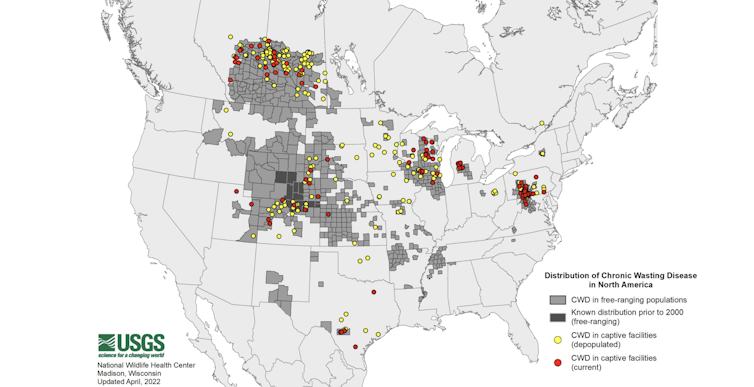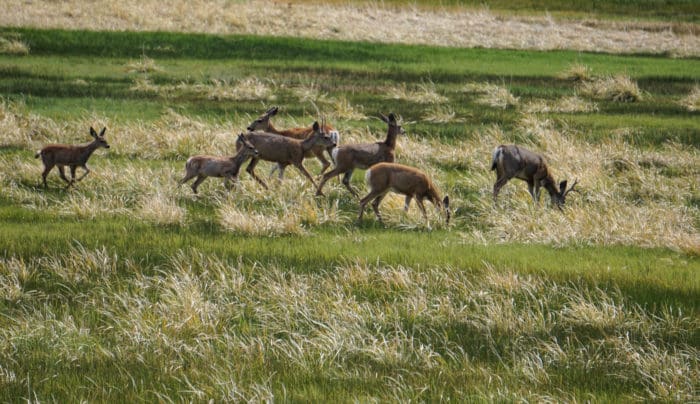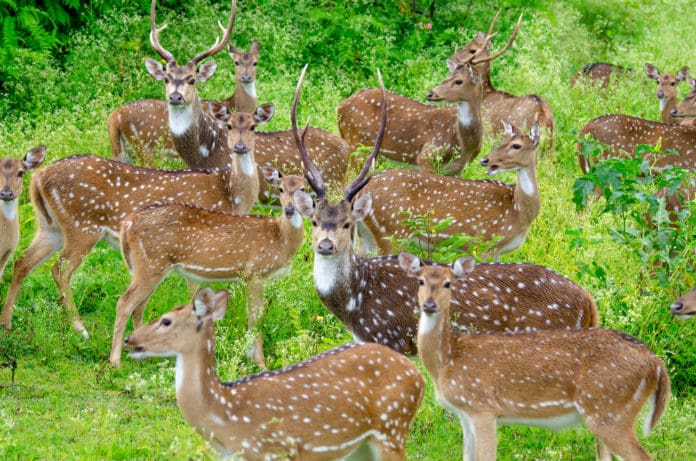By Allan Houston, University of Tennessee
Chronic wasting disease, a deadly neurological infectious disease that affects deer, elk and moose, is spreading across North America. Most recently detected in North Carolina in March 2022, CWD has been confirmed in 30 U.S. states and four Canadian provinces, as well as Norway, Finland, Sweden and South Korea. Dr. Allan Houston, a professor of forest and wildlife ecology at the University of Tennessee’s 18,400-acre Ames AgResearch and Education Center in western Tennessee, explains what is known about CWD and what wildlife scientists are trying to learn.
How does chronic wasting disease affect animals?
Chronic wasting disease is contagious and relentless. There is no cure, no way to test living animals, and once infections are introduced into wild populations, there is no realistic way to stop them from spreading.
An infected deer typically will survive for 18 months to two years. There’s a long incubation period in which they don’t usually show symptoms, but as the disease progresses, the animals will begin to appear listless and lose weight.
In the final six weeks or so they can seem aimless and oblivious to danger, become emaciated and drool. They often stand with their legs spread like sawhorses, as if trying not to topple over.
These so-called “zombie deer” often get media attention, but as the disease progresses in the wild, deer become more susceptible to other diseases, less able to protect themselves, more prone to predation and more apt to be hit by cars. They rarely live long enough to become zombies.

United States Geological Survey
How long have scientists known about CWD?
Chronic wasting disease was first detected in the mid-1960s when penned deer in Colorado began to exhibit symptoms generally described as “wasting away.” Researchers attributed it to stress until the late 1970s, when wildlife veterinarian Beth Williams performed necropsies on deer that had died of a similar syndrome. She found brain lesions consistent with transmissible spongiform encephalopathies – diseases of the nervous system that afflict both animals and humans.
In 1978, Williams and neuropathologist Stuart Young co-wrote the first scientific paper that described chronic wasting disease as a TSE. But the underlying cause remained a mystery.
A year later, neurologist Dr. Stanley Prusiner was studying TSE diseases and discovered that a very small protein could become misshapen and resistant to the body’s ability to take it apart. It entered cells, tricking them into replicating it, then moved into the lymph and nervous systems. Eventually it moved to the brain, where small clumps aggregated and caused TSE. Prusiner called that nonliving, infectious protein a “prion.”

Does CWD threaten humans?
Prion diseases are always fatal, but they don’t all affect the same species. The CWD prion favors cervids, or deerlike animals. Other prions cause human illnesses such as Creutzfeld-Jakob disease, a malady that progresses similarly to accelerated Alzheimer’s.
Bovine spongiform encephalopathy, popularly known as “mad cow disease,” is a prion disease that infects cattle. In a small number of cases, humans exposed to BSE have developed a version of Creutzfeld-Jakob disease.
No human case of CWD has ever been recorded. However, several laboratory experiments have shown that the CWD prion could be transferred to other mammals. The Centers for Disease Control and Prevention warns against eating meat from infected animals. Some infectious disease experts contend that “while the CWD threat to humans is low, it is not zero” and that risk assessments must include the potential for the emergence of new strains.
For example, while no one knows how or where CWD originated, some scholars think a mutated prion jumped the species barrier to deer from sheep infected with another animal prion disease called scrapie.
Why are prion diseases so hard to combat?
Because of their structure and the fact that they don’t contain genetic material, prions like the one that causes CWD are nearly indestructible. Breaking a prion apart, or denaturing it, would require a very high concentration of chlorine solution or heat exceeding 1,800 degrees F (980 C).
Once they are deposited on the landscape in urine or feces, CWD prions can persist for decades. Years after deer infected with chronic wasting disease were removed from pens, other deer placed on the contaminated soil in those same pens also became infected.
In wild herds the prion is spread as deer, which are highly social animals, groom and lick one another. During the fall mating season, bucks search for mates, fight and breed. They also visit spots known as scrapes, where they lick the soil and overhead branches where other deer have left their own calling cards. Thanks to these behaviors, bucks usually have CWD at double the rate of does.
Because the disease does not kill quickly, infected animals are able to breed for a season or two, so there is no strong genetic selection pressure favoring the development of herdwide immunity. And recent research suggests infected does can occasionally transmit the prion to their fawns before birth.
In some places where CWD occurs, the infection rate may only be 1% to 5%, and the disease’s herdwide impact may not be apparent, even to hunters. Elsewhere, the infection rate can reach 50% and maybe even 100%. In those cases, population impacts will inevitably lead to a smaller and younger herd.
What do hunters need to know?
No one wants a disease named after them. With infected deer often appearing healthy, even at close range post-harvest, the only way to be sure an animal is disease-free is to have it tested, usually using lymph nodes.
As CWD spreads and more people are having deer tested, it can take weeks to receive the results. That makes meat processing a much more onerous affair.
It is critical to recognize that once a single deer is infected it acts like tinder to ignite a conflagration. Moving deer around, either alive or dead, can introduce and spread the disease.
For example, transferring deer between breeding farms has been associated with its introduction. Disregarding state wildlife regulations that explain the proper ways to transport and dispose of harvested deer, elk or moose can also spread CWD. Feeding and baiting stations and salt licks can increase infection rates by concentrating deer and creating a point-source buildup of prions.
What do you want to learn about CWD?
CWD was detected in northern Mississippi and western Tennessee, where I work, in 2019. Based on what was then a relatively high infection rate, it had likely been on the landscape for a number of years and was spreading rapidly. Currently, about 40% of the Ames research station’s herd is infected.
Research on CWD has been ongoing for decades around the country. But it is in the South now. At Ames, in cooperation with other scientists from around the country, we are analyzing soil and twig samples for prion concentrations and quantifying deer visits at scrape sites and salt stations. We are also investigating ways to destroy salt stations to avoid continued exposure.
Other studies include training dogs to detect metabolites associated with the disease, and developing an early warning system before the prion can metastasize across a landscape.
We are studying how hunters react when CWD is detected locally, and comparing hunting success before and after a herd has become infected. The perspectives of hunters are important because they love the outdoors and are the first stopgap in CWD’s spread. Hunting is the primary tool for deer management, especially control of overabundant deer populations where CWD can run rampant.
Our deer hunters participate in the research at every step and often collect samples from deer they harvest. As one hunter said, “We’ve brought in everything except the tracks.”
We hope we can scale up our efforts along with other scientists as we analyze an ailing herd to provide insights into chronic wasting disease for the benefit of animals and humans alike.![]()
Allan Houston, Professor of Forest and Wildlife Ecology, University of Tennessee
This article is republished from The Conversation under a Creative Commons license. Read the original article.





Its Putin’s fault.
Pretty sure Joe Biden has CWD.
C’mon man, I can’t do anything about that right now. There’s a lot of major things we’ve done. But, what we haven’t done, is we haven’t been able to communicate it in a way that is…uh …um…let let me say it another way…Well, look how the press has changed.
You sure it ain’t Trumps fault?
I blame Bush. Katrina was Bush’s fault, global warming was Bush’s fault, AIDS was Bush’s fault, everything was Bush’s fault. I haven’t forgotten all of that! CWD is small potatoes for a demigod who can wreck in his spare time!
AIDS was Reagan’s fault.
Bush was personally responsible for saving the lives of at least 10 million people in Africa. Google ‘PEPFAR’. Yet BO won the Nobel Peace Prize for not being Bush.
Best explanation for the origin I’ve ever heard, are farms. Catch them, pen them up, then feed them things they were never meant to eat. Animal proteins in herbivore feed has often been blamed for animal diseases such as this. Herbivores were never intended by God or by nature to eat feather meal, bone meal, or any other meat byproducts. Yet, we did so, in our quest to increase protein intake, and rapid growth. And, of course, once Pandora opens her box, it’s much to late to correct our mistakes.
Your going to make the cows mad.
There’s animals who are natural cannibals. Certain species of snakes and fish come to mind. Herbivorous animals are most definitely NOT natural cannibals, and prionic diseases are a natural result of unnatural behavior.
There is no other way than enacting a cull and AS SOON AS POSSIBLE HOw to identify? I do not know but I took part in the UK BOVINE CULL for MAD COW DISEASE and anything over two years was banned from the food chain and ALL BRAIN, SPINAL CORD, HEADS and TONGUES were withdrawn from the food chain by myself and other Certified Meat Inspectors/Veterinary Auxilliaries and the carcases incinerated at high temeperatures. It apparently NOT sufficient to use outdoor bonfires because they do nor reach a high enough temperature to destro PRIONS. How you can apply this to wildlife is beyond me. Mobile incinerators perhaps? But it is, as far as I know, the only way. In the meantime I’d not be eating Gamemeat from ANY deer species
This disease appears in WILD GAME that has never had access to other than a herbivour diet. THere is very good evidence from the UK that the ORIGINAL infection of MAD COW disease was from IMPORTED WILD VENISON and not from the consumption nessessarily of animal protein per.sec. However the real causes are still somewhat vague.
But the fact is that there were NO proven transmissions of MAD COW DISEASE to humans.K-J disease is a similar disease that occurs inn humans. There is a very similar disease in sheep and sheep have not been culled in the a same way as Bovines and there is no record that ‘MAD sheep disease is transmissible to humans.
…it’s been showing up here in north Idaho over the last year.
I never have liked venison. Saying that is like saying “I like to kick dogs” to some people.
I really like elk and quail. Everybody has different likes,
The secret to quality meat of any kind, but especially wild game, isn’t a secret. It’s processing and preparation. That said, I will not eat liver no matter what.
Me neither, not anymore anyway.
Gadsden Flag for the win!
I have had both venison and black bear that tasted terrible. Along the same lines, I have had both venison and black bear that taste fantastic.
As Gadsden Flag stated, processing and preparation are critical to great flavor. It also helps if the critters are eating good food. For example white-tailed deer in cold climates that eat a lot of cedar taste pretty awful. Of course white-tailed deer that eat a lot of corn, soy beans, alfalfa, acorns, and other foliage taste wonderful–when you process and prepare them correctly.
NO ‘processing’ can negate the PRION that cause this kind of disese
Prions are Nature’s Way of controlling over-breeding.
Humans take note !
Prions are some creepy things. Same with that fungus that causes the zombie ant disease. Weird shit.
TTAE…… The Truth About Elk
.
fify
I was driving down the road and noticed Bob had a deer tied up in his yard. I pulled in and said ” Oh you got a pet deer.” He say ” yeah it just came up out of the timber so I tied it up( twine string) so Lois can see it when she gets back.” Me ” Uh I dont know Bob, I think the fckers sick I wouldn’t get around it.”
Next day, “Hows that deer Bob?”
He say, “Eh, it died before Lois got home.”
In England, BSE was traced to large slaughter house operations grinding up left over bits, like sheep brains and nerves, and putting them in cattle feed. After living in Britain for a year in the early 1990s, I am not allowed to donate blood.
Years ago, the news had a story about a brain surgeon at the University of Wisconsin -Madison insisting on new surgical tools for every surgery. His claim was even super duper cleaning methods wouldn’t get the prions off the equipment.
Over 20 years ago, a pair of hunters from northern Wisconsin both developed Creutzfeldt-Jakob disease, the human form of BSE. They would annually have a hunters feast every fall, eating some of all they shot the previous year.
Sometime in the past a group of Tennessee hunters came down with Creutzfeldt — Jakob disease. Seems they hunted squirrels and once a year had a feast of squirrel brains. How the prions got into squirrel brains is beyond me. One theory is we are genetically predisposed…one way and the stuff won’t touch you. The other way…one contaminated bite will grow in you, your body never defeating it, and eventually you will succumb. Of course, it could take long enough that you will die of something else.
damn it! Now I can’t eat the squirrels that run through my yard.
Next it will be the cats, then the Robins, I can’t eat.
Had me up to the part where it said it’s heat resistant to 1,800 F
WHO lists Prions destruction at 273 F
Why is this important? Well, it means you can cook the meat and it be safe as long as its cooked above 273 F for 30 min.
As opposed to the article above which would reduce everything to carbon.
It then claims this protein can stay active for decades.
Been known about since the 70’s but today we need to eradicate the deer population in order to save them from a protein that is indestructible and never ages?
Up next, 223 banned from deer hunting because it blows the deers lung clear out its body.
No, it’s going to be after the CDC “discovers” that it’s all been misdiagnosed and is actually caused by lead ingestion at much lower levels than previously thought possible.
A 223 won’t blow the lungs out of a deer but a 338/378 Weatherby will. Ask me how I know that….
WHO is wrong, 1800 is correct. Bleach has also been shown to have positive effects. The box is opened on this one and I have a hard time thinking that they will figure this one out. My biggest fear is not that it could affect humans. My biggest concern is that it makes it into the cattle herd.
I’d love to see anything organic like a protein strand survive past 1000, let alone 1800F
Biden and his ilk created this prion
Comments are closed.